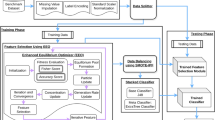Abstract
One-class classification is an important problem with applications in several different areas such as novelty detection, anomaly detection, outlier detection and machine monitoring. In this paper, we propose two novel methods for one-class classification, referred to as NNDDSRM and kNNDDSRM. The methods are based on the principle of structural risk minimization and the nearest neighbor data description (NNDD) one-class classifier. Experiments carried out using both artificial and real-world datasets show that the proposed methods are able to significantly reduce the number of stored prototypes in comparison to NNDD. The experimental results also show that the proposed methods outperformed NNDD—in terms of the area under the receiver operating characteristic (ROC) curve—on four of the five datasets considered in the experiments and had a similar performance on the remaining one.












Similar content being viewed by others
References
Oliveira ALI, Meira SRL (2006) Detecting novelties in time series through neural networks forecasting with robust confidence intervals. Neurocomputing 70:79–92
Japkowicz N, Myers C, Gluck MA (1995) A novelty detection approach to classification. In: Proceedings of the fourteenth international joint conference on artificial intelligence, pp 518–523
Duda RO, Hart PE (1973) Pattern classification and scene analysis. Wiley, New York
Karacali B, Krim H (2003) Fast minimization of structural risk by nearest neighbor rule. IEEE Trans Neural Netw 14:127–137
Cao LJ, Lee HP, Chong WK (2003) Modified support vector novelty detector using training data with outliers. Pattern Recognit Lett 24:2479–2487
Ma J, Perkins S (2003) Time series novelty detection using one-class support vector machines. Proc Int Joint Conf Neural Netw 3:1741–1745
Markou M, Singh S (2003) Novelty detection: a review—part I: statistical approaches. Signal Process 83:2481–2497
Markou M, Singh S (2003) Novelty detection: a review—part II: neural network based approaches. Signal Process 83:2499–2521
Marsland S (2003) Novelty detection in learning systems. Neural Comput Surv 3:157–195
Marsland S, Nehmzow U, Shapiro J (2005) On-line novelty detection for autonomous mobile robots. Rob Auton Syst 51:191–206
Singh S, Markou M (2004) An approach to novelty detection applied to the classification of image regions. IEEE Trans Knowl Data Eng 16:396–406
Oliveira ALI, Melo BJM, Meira SRL (2005) Improving constructive training of RBF networks through selective pruning and model selection. Neurocomputing 64:537–541
Oliveira ALI, Melo BJM, Meira SRL (2005) Integrated method for constructive training of radial basis functions networks. Elect Lett 41:429–430
Tax DMJ (2001) One-class classification. Ph.D. Thesis, Delf University of Technology. http://www.ph.tn.tudelft.nl/~davidt/papers.html
Fawcett T (2006) An introduction to ROC analysis. Pattern Recognit Lett 27:861–874
UCI machine learning repository. http://www.ics.uci.edu/~mlearn/MLRepository.html
Campbell C, Bennett KP (2001) Linear programming techniques for novelty detection. Advances in Neural Information Processing 13. Statlib data. http://lib.stat.cmu.edu/datasets
Oliveira ALI, Neto FBL, Meira SRL (2004) Improving novelty detection in short time series through RBF-DDA parameter adjustment. Proc Int Joint Conf Neural Netw 3:2123–212
Acknowledgments
The authors would like to thank CNPq (Brazilian Research Agency) and FACEPE (Pernambuco Reseach Agency) for their financial support.
Author information
Authors and Affiliations
Corresponding author
Rights and permissions
About this article
Cite this article
Cabral, G.G., Oliveira, A.L.I. & Cahú, C.B.G. Combining nearest neighbor data description and structural risk minimization for one-class classification. Neural Comput & Applic 18, 175–183 (2009). https://doi.org/10.1007/s00521-007-0169-8
Received:
Accepted:
Published:
Issue Date:
DOI: https://doi.org/10.1007/s00521-007-0169-8




